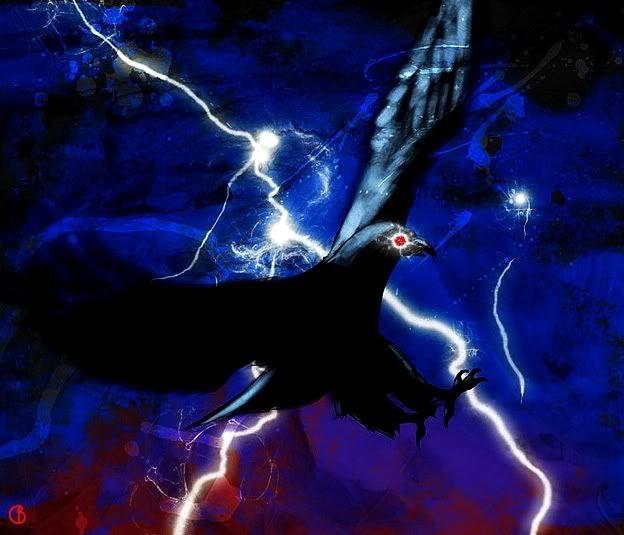 The legend of the Thunderbird is an ancient myth that survives even to the present day in some Native American cultures. Though the Thunderbird myth varied from region to region and tribe to tribe, the Thunderbird was, in the eyes of the ancient Native Americans, a magical animal that was sent by their gods to protect them from the powers of evil. Riding on the wings of the storm, the Thunderbird embodied the power of the storm. Its eyes flashed fire, its cry was like the crack of lightning, and its mighty wings beat with the sound of rolling thunder, ever protecting its people from the powers of evil.
The legend of the Thunderbird is an ancient myth that survives even to the present day in some Native American cultures. Though the Thunderbird myth varied from region to region and tribe to tribe, the Thunderbird was, in the eyes of the ancient Native Americans, a magical animal that was sent by their gods to protect them from the powers of evil. Riding on the wings of the storm, the Thunderbird embodied the power of the storm. Its eyes flashed fire, its cry was like the crack of lightning, and its mighty wings beat with the sound of rolling thunder, ever protecting its people from the powers of evil.There are at least three different legends of the Thunderbird available to us today, that can give us some information about what this creature was like. The first comes from the Winnebago Indians of the northern Midwest and Plains states, a second comes from the Passamaquoddy Indians of Maine, and a third comes from the Quillayute, a Chimakoan tribe living along the Quillayute River, a six-mile river on the Olympic Peninsula, near Seattle, Washington.
The Winnebago were an ancient and powerful people that once spread out from Wisconsin all across the northern Midwest and Plains states to Nebraska. They believed that the Thunderbirds were powerful, eagle-like divine creatures that were able to affect the winds and created storms, lightning, thunder, and rain. They also believed that they could take the form of humans, and that some humans, though not actually Thunderbirds, shared their characteristics and were considered to be semi-divine.
This thought is reminiscent of the "bird-man" concept prevalent at Cahokia, and it is believed that the Cahokians were related to the Winnebago peoples. Richard L. Dieterle explains in The Short Encyclopedia of Hotcâk (Winnebago) Myth, Legend, and Folklore,Thunderbirds are powerful and warlike avian spirits who animate the gray clouds with thunder and lightning.
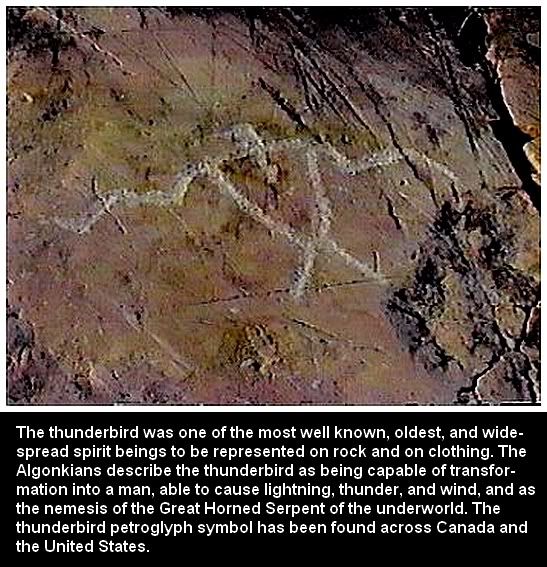 Together with the Waterspirits, they were the first spirits that Earthmaker created. Their name, Wak'âdja, means, "Divine Ones." On the model of other tribes, they are conventionally called "Thunderbirds," since they alone possess lightning. Their basic somatic form runs the gamut of several species of birds, the hawk and the eagle being the most common. However, they are far stronger in build and have polychrome plumage that gives them a magnificent appearance unrivaled by the birds of earth. Their voices are like the sounds of flutes, recalling both the whistle of wind and the voices of raptors.
Together with the Waterspirits, they were the first spirits that Earthmaker created. Their name, Wak'âdja, means, "Divine Ones." On the model of other tribes, they are conventionally called "Thunderbirds," since they alone possess lightning. Their basic somatic form runs the gamut of several species of birds, the hawk and the eagle being the most common. However, they are far stronger in build and have polychrome plumage that gives them a magnificent appearance unrivaled by the birds of earth. Their voices are like the sounds of flutes, recalling both the whistle of wind and the voices of raptors.Another primary source is from the legends of the Passamaquoddy Indians, who lived in the northeast, in the Quoddy Loop area of Maine and New Brunswick. In this story, two Passamaquoddy Indians went on a quest to find the origin of thunder:
This is a legend of long, long ago times. Two Indians desired to find the origin of thunder. They travelled north and came to a high mountain. These mountains performed magically. They drew apart, back and forth, then closed together very quickly. One Indian said, "I will leap through the cleft before it closes. If I am caught, you continue to find the origin of thunder." The first one succeeded in going through the cleft before it closed, but the second one was caught and squashed. On the other side, the first Indian saw a large plain with a group of wigwams, and a number of Indians playing a ball game. After a little while, these players said to each other, "It is time to go." They disappeared into their wigwams to put on wings, and came out with their bows and arrows and flew away over the mountains to the south. This was how the Passamaquoddy Indian discovered the homes of the thunderbirds.
The surviving Passamaquoddy Indian brave had discovered the home of the Thunderbirds, but the intrepid Indians who had set out on a quest for the source of thunder had gotten more than they had bargained for. One Indian had died already, and his companion was about to undergo a transformation:
The remaining old men of that tribe asked the Passamaquoddy Indian, "What do you want? Who are you?" He replied with the story of his mission. The old men deliberated how they could help him. They decided to put the lone Indian into a large mortar, and they pounded him until all of his bones were broken. They moulded him into a new body with wings like thunderbird, and gave him a bow and some arrows and sent him away in flight. They warned him not to fly close to trees, as he would fly so fast he could not stop in time to avoid them, and he would be killed.
The Thunderbirds, according to the Passamaquoddy, were men who could transform themselves into flying creatures. These men were also able to transform the Passamaquoddy Indian brave into a bird like themselves. However, this brave now had a new enemy: Wochowsen, "great bird from the south", who had control of the south wind, and made it blow so hard that the Passamaquoddy brave could not return to his homeland.
The lone Indian could not reach his home because the huge enemy bird, Wochowsen, at that time made such a damaging wind. Thunderbird is an Indian and he or his lightning would never harm another Indian. But Wochowsen, great bird from the south, tried hard to rival Thunderbird. So Passamaquoddies feared Wochowsen, whose wings Glooscap once had broken, because he used too much power. A result was that for a long time air became stagnant, the sea was full of slime, and all of the fish died. But Glooscap saw what was happening to his people and repaired the wings of Wochowsen to the extent of controlling and alternating strong winds with calm. Legend tells us this is how the new Passamaquoddy thunderbird, the lone Indian who passed through the cleft, in time became the great and powerful Thunderbird, who always has kept a watchful eye upon the good Indians.
A belief in the magic of the Thunderbird is held by the Passamaquoddy, because he can tame the winds alternating between calm and storms. In this way the Thunderbird was not merely seen as a large, natural flying creature, but as at least a semi-supernatural creature with ties to the divine world above.
Another Thunderbird story can be found in the myths and legends of the Quillayute Indians of the Pacific Northwest. In this story, disaster had struck the
Quillayute - rain and hail had fallen for many days, destroying all of the edible plants and making it impossible to fish. Many of their people had been killed by the hail, which was followed by sleet and snow. Out of food, the Quillayute were desperate, and the Great Chief was forced to call upon the Great Spirit for help. The Great Spirit answered, sending them the Thunderbird:
Quillayute - rain and hail had fallen for many days, destroying all of the edible plants and making it impossible to fish. Many of their people had been killed by the hail, which was followed by sleet and snow. Out of food, the Quillayute were desperate, and the Great Chief was forced to call upon the Great Spirit for help. The Great Spirit answered, sending them the Thunderbird:
The people waited. No one spoke. There was nothing but silence and darkness. Suddenly, there came a great noise, and flashes of lightning cut the darkness. A deep whirring sound, like giant wings beating, came from the place of the setting sun. All of the people turned to gaze toward the sky above the ocean as a huge, bird-shaped creature flew toward them. This bird was larger than any they had ever seen. Its wings, from tip to tip, were twice as long as a war canoe. It had a huge, curving beak, and its eyes glowed like fire. The people saw that its great claws held a living, giant whale. In silence, they watched while Thunderbird - for so the bird was named by everyone - carefully lowered the whale to the ground before them. Thunderbird then flew high in the sky, and went back to the thunder and lightning it had come from. Perhaps it flew back to its perch in the hunting grounds of the Great Spirit. Thunderbird and Whale saved the Quillayute from dying. The people knew that the Great Spirit had heard their prayer. Even today they never forget that visit from Thunderbird, never forget that it ended long days of hunger and death. For on the prairie near their village are big, round stones that the grandfathers say are the hardened hailstones of that storm long ago.
The Quillayute described the Thunderbird as essentially a very large bird, though no bird in history was ever as big as the type of bird they described, and of course no other bird ever had the same supernatural powers:
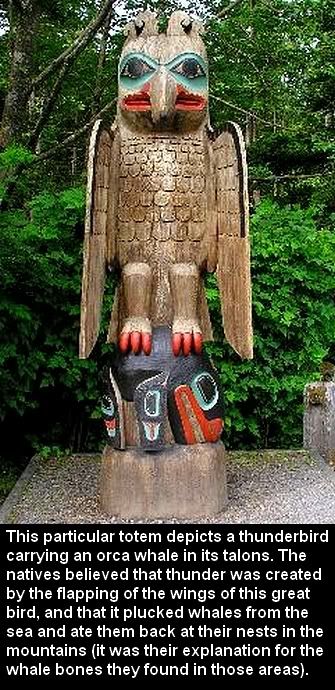 Thunderbird is a very large bird, with feathers as long as a canoe paddle. When he flaps his wings, he makes thunder and the great winds. When he opens and shuts his eyes, he makes lightning. In stormy weather, he flies through the skies, flapping his wings and opening and closing his eyes. Thunderbird's home is a cave in the Olympic Mountains, and he wants no one to come near it. If hunters get close enough so he can smell them, he makes thunder noise, and he rolls ice out of his cave. The ice rolls down the mountainside, and when it reaches a rocky place, it breaks into many pieces. The pieces rattle as they roll farther down into the valley. All the hunters are so afraid of Thunderbird and his noise and rolling ice that they never stay long near his home. No one ever sleeps near his cave. Thunderbird keeps his food in a dark hole at the edge of a big field of ice and snow. His food is the whale. Thunderbird flies out of the ocean, catches a whale and hurries back to the mountains to eat it. One time Whale fought Thunderbird so hard that during the battle, trees were torn up by their roots. To this day there are no trees in Beaver Prairie because of the fight Whale and Thunderbird had that day.
Thunderbird is a very large bird, with feathers as long as a canoe paddle. When he flaps his wings, he makes thunder and the great winds. When he opens and shuts his eyes, he makes lightning. In stormy weather, he flies through the skies, flapping his wings and opening and closing his eyes. Thunderbird's home is a cave in the Olympic Mountains, and he wants no one to come near it. If hunters get close enough so he can smell them, he makes thunder noise, and he rolls ice out of his cave. The ice rolls down the mountainside, and when it reaches a rocky place, it breaks into many pieces. The pieces rattle as they roll farther down into the valley. All the hunters are so afraid of Thunderbird and his noise and rolling ice that they never stay long near his home. No one ever sleeps near his cave. Thunderbird keeps his food in a dark hole at the edge of a big field of ice and snow. His food is the whale. Thunderbird flies out of the ocean, catches a whale and hurries back to the mountains to eat it. One time Whale fought Thunderbird so hard that during the battle, trees were torn up by their roots. To this day there are no trees in Beaver Prairie because of the fight Whale and Thunderbird had that day.The battle between Thunderbird and Whale appears to be primarily symbolic of the battle between the air and the sea, as imagined by the Quillayute in their attempt to interpret the forces of nature. Like most ancient peoples, the Quillayute interpreted the forces of nature in symbolic forms, inventing gods and goddesses, deities, and demigods as causes of these phenomena.
At the time of the Great Flood, Thunderbird fought a long, long battle with Killer Whale. He would catch Killer Whale in his claws and start with him to the cave in the mountains. Killer Whale would escape and return to the water. Thunderbird would catch him again, all the time flashing lightning from his eyes and flapping his wings to create thunder. Mountains were shaken by the noise, and trees were uprooted in their struggle. Again and again Killer Whale escaped. Again and again Thunderbird seized him. Many times they fought, in different places in the mountains. At last Killer Whale escaped to the middle of the ocean, and Thunderbird gave up the fight. That is why Killer Whales live in the deep oceans today. That is why there are many prairies in the midst of the forests on the Olympic Peninsula.
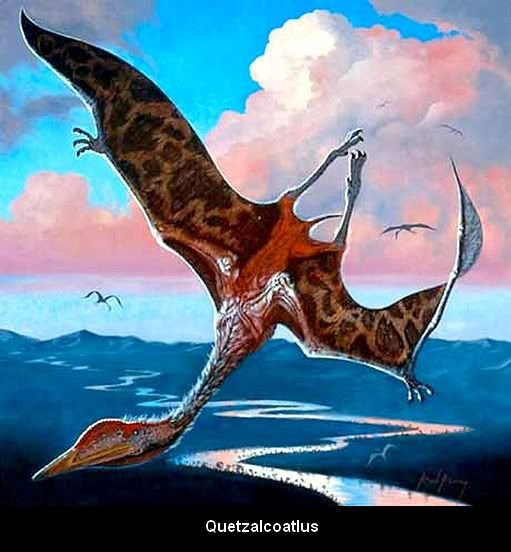 It is interesting that the Quillayute mention the "Great Flood" in their description of the battle between Thunderbird and whale. The story of a Great Flood that covered the Earth at one time is nearly universal throughout the ancient world - but that is a story for another time.
It is interesting that the Quillayute mention the "Great Flood" in their description of the battle between Thunderbird and whale. The story of a Great Flood that covered the Earth at one time is nearly universal throughout the ancient world - but that is a story for another time.The Quillayute legend describes the Thunderbird as a giant flying creature with feathers. According to the geologic record, no avian (bird) was ever as large as the creature that the Quillayute described. However, there were flying creatures that were that large - the giant pterosaur Quetzalcoatlus Northropi, native to the Mesozoic Period. With a wingspan of 33 feet, Quetzalcoatlus Northropi was possibly the largest flying creature on earth in any period. A fully grown Quetzalcoatlus was also quite capable of catching and carrying off a small whale like the Killer Whale. Absurd as this might seem, there have been sightings of similar creatures all the way up to the present day in various parts of the world.
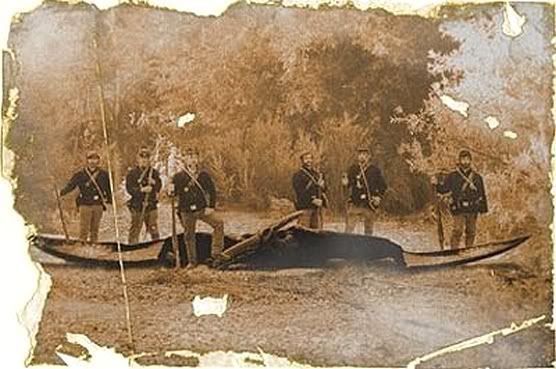 One problem with this theory is the fact that the Thunderbird is described as having feathers. However, recent evidence out of China suggests that at least some dinosaurs may have had feathers. One controversial photo, which has now been lost (if it ever truly existed), shows a pterodactyl-like creature with feathered wings being displayed by a group of men as a sort of hunting trophy. This controversial photo, some believe was a sort of urban legend, a thing that never happened but was believed by many to be true, despite the fact that large-scale searches have been made for the photo without success.
One problem with this theory is the fact that the Thunderbird is described as having feathers. However, recent evidence out of China suggests that at least some dinosaurs may have had feathers. One controversial photo, which has now been lost (if it ever truly existed), shows a pterodactyl-like creature with feathered wings being displayed by a group of men as a sort of hunting trophy. This controversial photo, some believe was a sort of urban legend, a thing that never happened but was believed by many to be true, despite the fact that large-scale searches have been made for the photo without success.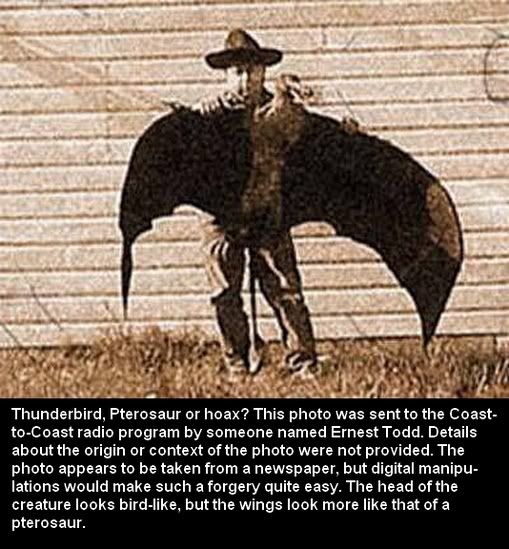 The most celebrated Thunderbird encounter took place in 1890, on the desert sands of what was then the Arizona Territory. Two cowboys had a bizarre confrontation which has varied widely in the telling, but the gist of the story is this: they saw a giant flying bird, shot and killed it with their rifles, and carried its spectacular carcass into town. A report in the April 26, 1890 Tombstone Epigraph listed the creature's wingspan as an alarming 160 feet, and noted that the bird was about 92 feet long, about 50 inches around at the middle, and had a head about eight feet long. The beast was said to have no feathers, but a smooth skin and wingflaps "composed of a thick and nearly transparent membrane... easily penetrated by a bullet." Perhaps the hardest part of this story to swallow is that two horses could manage to haul a dead behemoth like this for any distance. The Tombstone newspaper printed its highly embroidered version of the cowboy's sighting, which was spared from fading into obscurity by its inclusion in a 1930 book on the Old West.
The most celebrated Thunderbird encounter took place in 1890, on the desert sands of what was then the Arizona Territory. Two cowboys had a bizarre confrontation which has varied widely in the telling, but the gist of the story is this: they saw a giant flying bird, shot and killed it with their rifles, and carried its spectacular carcass into town. A report in the April 26, 1890 Tombstone Epigraph listed the creature's wingspan as an alarming 160 feet, and noted that the bird was about 92 feet long, about 50 inches around at the middle, and had a head about eight feet long. The beast was said to have no feathers, but a smooth skin and wingflaps "composed of a thick and nearly transparent membrane... easily penetrated by a bullet." Perhaps the hardest part of this story to swallow is that two horses could manage to haul a dead behemoth like this for any distance. The Tombstone newspaper printed its highly embroidered version of the cowboy's sighting, which was spared from fading into obscurity by its inclusion in a 1930 book on the Old West.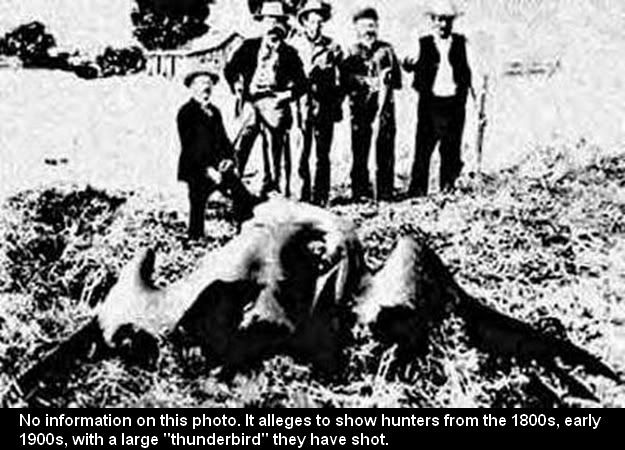 In 1963, the story came to the attention of writer Jack Pearl, who revived the tale for an article in a pulpy men's adventure magazine called Saga. As if the Epigraph report hadn't spiced up the facts enough already, Pearl liberally embellished the encounter into a dramatic rip-snorter entitled "Monster Bird That Carries Off Human Beings!" Pearl pushed the date of the encounter back to 1886, and he described the witnesses as two prospectors who killed the bird and proudly showed off their trophy in Tombstone. Pearl also added some extra conflict by telling of a how a second Thunderbird snatched up a heckler who had ridiculed the prospectors and flew away with him in its talons. But Pearl's most significant editorialization was this: he said that the Epigraph newspaper story had run with a photograph of the giant bird's carcass, nailed up to a wall with its mighty wingspan unfurled, and a number of men posing next to it for scale.
In 1963, the story came to the attention of writer Jack Pearl, who revived the tale for an article in a pulpy men's adventure magazine called Saga. As if the Epigraph report hadn't spiced up the facts enough already, Pearl liberally embellished the encounter into a dramatic rip-snorter entitled "Monster Bird That Carries Off Human Beings!" Pearl pushed the date of the encounter back to 1886, and he described the witnesses as two prospectors who killed the bird and proudly showed off their trophy in Tombstone. Pearl also added some extra conflict by telling of a how a second Thunderbird snatched up a heckler who had ridiculed the prospectors and flew away with him in its talons. But Pearl's most significant editorialization was this: he said that the Epigraph newspaper story had run with a photograph of the giant bird's carcass, nailed up to a wall with its mighty wingspan unfurled, and a number of men posing next to it for scale.So, despite the existence of plenty of secondary evidence, the quest for an actual photo or other decisive evidence for the existence of a Thunderbird continues on. Like the quest for Piasa, dragons, and other mythical monsters, the Thunderbird and its paranormal ilk continue to live on the fringes of human perception, waiting for the lucky snapshot to snap them into focus.
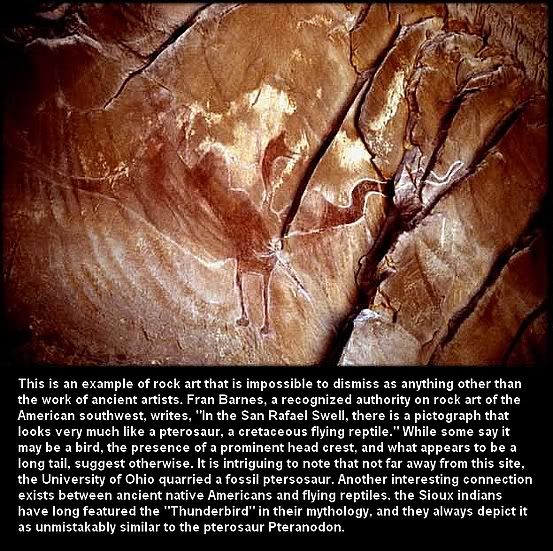
4 comments:
Thanks for this information...In an northern Canada native naming ceremony...I was named as a member of the Red Thunderbird Clan...your information has helped me to understand what a thunderbird is and represented.
Tammy
I notice you are using graphics from my site without giving me credit. As you already know, I assign a source to every graphic I use on my site "The Cryptozoologist". You have used my text, but removed the source credit. I would appreciate your giving credit where credit is due in the future.
The Cryptozoologist
Hi, I am a student at Southern Utah University where our mascot is a Thunderbird. I have decided to do a class project on the origin of the Thunderbird and to possibly find out why it was named as our mascot. Many people here have no idea what a Thunderbird, or T-Bird as we refer to it here, is or why it is our mascot. I have found your website very informational and enlightening. It is very interesting how so many cultures from the Western United States, Canada and (possibly even Mexico) have a similar story of this legendary bird.
Thank you for sharing this information!
Katy
About 25 years ago, I was outside hitting a baseball across the field, and caught sight of this gigantic beast that has been said to be long extinct. I remember freezing part out of fear, part of fascination of what I was seeing. Now this thing had nearly crossed directly over me, flying just above the treetops at around 40 to 50 feet, and around a 100 feet away from me. There wasn't a doubt in my mind this thing could have easily killed me and carried me off. As I watched this thing, I had so many questions run through my mind, like I wish I had a camera to take as many pictures or video, why, or how has the world not known this thing is still around, it seems a bit ridiculous something this size could remain a mystery. I wished I had a firearm, and I wanted to share this experience with the entire world. It was absolutely amazing, and a stunning sight. It had a enormous wingspan, with these thin, leathery, long wings that ended with a little point on the end. A batwing is the closest thing that comes to mind, but I've never known a bat to be reported having such a large wingspan. The head was another thing that really stuck out, because it extended far behind the eye, with the mouth extending far ahead of the eye. I had a full side profile of this creature the entire time I was able to view it. I know it flaps its wings, then gilded a long distance, than flapped them once again before flying out of sight. This bird had long legs, that it kept tucked backwards like a tail, but the tail was serpent like, but my memory has always been kinda fuzzy when it comes to the details of the tail. I almost want to say it had a spade on the end of it. I know I had no doubts that this was a prehistoric beast, said to have been long dead, but if you ever see one up close like that, you know without a doubt what you are seeing. It was so fluid and graceful in all of this movements, from the head ever so slightly scanning the ground, and the way the body moved when it would extend and swoop its wings down. It looked to be around just a long as it was wide which I would guess to be around the 40 to 45 feet. it was definitely as large as a small cessna airplane. Another thing I realized, was even though this thing had flown over a neighborhood, I appeared to be the only person outside, and I figure maybe that may be why we miss these things, is that people spend more time within a box, than they do outdoors. I had always had a fascination with being outdoors, and running and exploring the woods. I have had such close encounters with everyday animals people would not believe. I really don't want to come forward and be ridiculed by the world, there is plenty of that anywhere you go. I'm a tracker, trapper, hunter, and observer in the wild. I've had years of experience with animals, and even taught myself how to tan animal hides, and make clothing. I'm going to leave this here, and you can believe what you wish.
Post a Comment